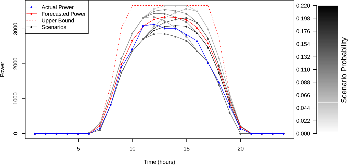Constructing probabilistic scenarios for wide-area solar power generation
- Univ. of California, Davis, CA (United States). Graduate School of Management
- Sandia National Lab. (SNL-NM), Albuquerque, NM (United States). Discrete Math and Optimization Dept.
- Univ. of Duisburg-Essen (Germany). Dept. of Mathematics
- Demand Energy Networks, Liberty Lake, WA (United States)
Optimizing thermal generation commitments and dispatch in the presence of high penetrations of renewable resources such as solar energy requires a characterization of their stochastic properties. In this study, we describe novel methods designed to create day-ahead, wide-area probabilistic solar power scenarios based only on historical forecasts and associated observations of solar power production. Each scenario represents a possible trajectory for solar power in next-day operations with an associated probability computed by algorithms that use historical forecast errors. Scenarios are created by segmentation of historic data, fitting non-parametric error distributions using epi-splines, and then computing specific quantiles from these distributions. Additionally, we address the challenge of establishing an upper bound on solar power output. Our specific application driver is for use in stochastic variants of core power systems operations optimization problems, e.g., unit commitment and economic dispatch. These problems require as input a range of possible future realizations of renewables production. However, the utility of such probabilistic scenarios extends to other contexts, e.g., operator and trader situational awareness. Finally, we compare the performance of our approach to a recently proposed method based on quantile regression, and demonstrate that our method performs comparably to this approach in terms of two widely used methods for assessing the quality of probabilistic scenarios: the Energy score and the Variogram score.
- Research Organization:
- Sandia National Lab. (SNL-NM), Albuquerque, NM (United States)
- Sponsoring Organization:
- USDOE Advanced Research Projects Agency - Energy (ARPA-E); USDOE Office of Energy Efficiency and Renewable Energy (EERE), Renewable Power Office. Solar Energy Technologies Office; USDOE National Nuclear Security Administration (NNSA)
- Grant/Contract Number:
- NA0003525; 1.4.26
- OSTI ID:
- 1421637
- Alternate ID(s):
- OSTI ID: 1548976
- Report Number(s):
- SAND2017-13497J; 659503
- Journal Information:
- Solar Energy, Vol. 160; ISSN 0038-092X
- Publisher:
- ElsevierCopyright Statement
- Country of Publication:
- United States
- Language:
- English
Web of Science
A novel method for day-ahead solar power prediction based on hidden Markov model and cosine similarity
|
journal | July 2019 |
| EMSx: a numerical benchmark for energy management systems | text | January 2020 |
Similar Records
Integrating Solar PV in Utility System Operations
A hybrid data-driven and model-based approach for computationally efficient stochastic unit commitment and economic dispatch under wind and solar uncertainty
















